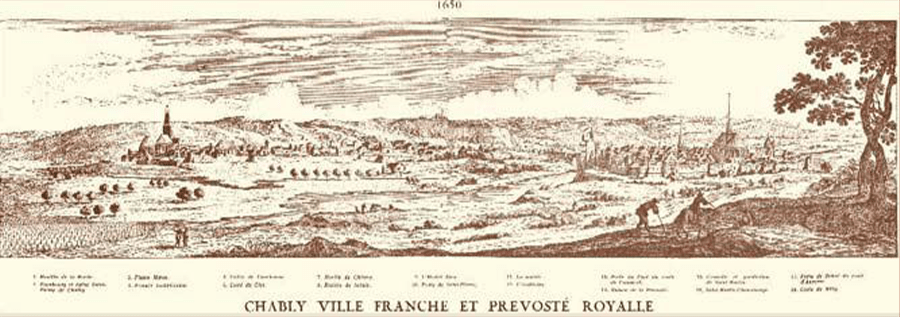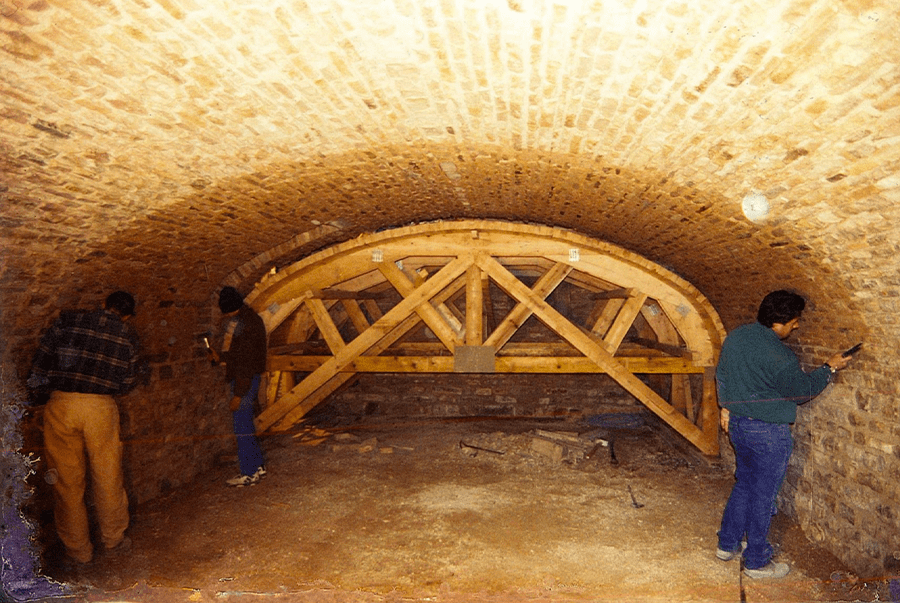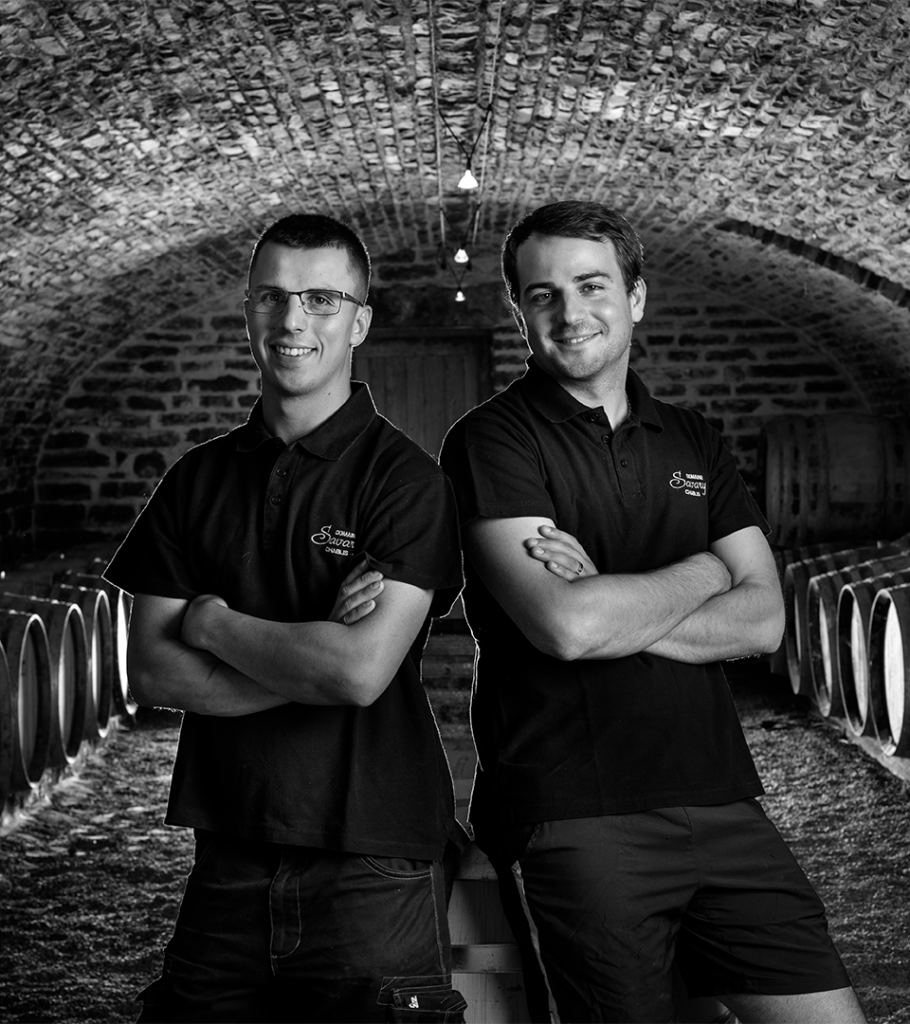
267

The know origins of Chablis date back to the 2nd century BC. At that time, there was a Gaulish village at the southern entrance of the town that exists today. The first vines were likely planted some time during the 1st century AD. It was not until the 3rd century AD that they were truly developed, however, under the Roman Emperor Probus.
Various sources
The origins of Chablis wine country

867

In 854, the monks of Tours, fleeing the Viking invasion, took refuge at the Abbey of Saint-Germain d'Auxerre, bringing with them the relics of their patron, Saint Martin. In 867, Charlemagne's grandson Charles II the Bald gave the monks of Tours the small town of Chablis and the monastery of Saint-Loup, where they brought the relics of Saint-Martin ten years later. They cultivated the vines on the slopes facing the river Serein, which became the historic heart of Chablis wine-making country and is where the Grands Crus ara now made. In 1118, the monks of Saint-Martin de Tours granted their fellow monks of Pontigny the right to cultivate thirty-six arpents of vines around Chablis (equivalent to approximately twenty-two hectares). To make and store their wine, they had the "Petit Pontigny" built in Chablis. The wine cellar exists to this day, and hosts numerous vigneron events as well as the Bureau Interprofessionel des Vins de Bourgogne (the Interprofessional Burgundy Wine Office).
From the 13th century onwards, Chablis wines grew both geographically and commercially, contributing significantly to the town's new-found wealth, and for a long period provided the main source of income locally. The first official proclamation announcing the date of the harvest, know in French as the "ban", appeared in 1230. by 1328, there were some four hundred and fifty landowerns cultivating 500 hectares of vines. The wines they produced were carried overland Auxerre, before being loaded into boats for the journey along the Yonne to Paris, and then on to Rouen to be exported to northern Europe. Said in the words of the French idiom to be "white as rock water" or crystal clear, and "long storing", they quickly acquired a distinctive status in France.
Various sources
The Middle Ages

1035

Mentioned by the name of "Merlenniacus" in the year 1035, Maligny was at that time a fiefdom within the Comté of Champagne, and later the Comté of Saint-Florentin. The village was the original home a large family whose possessions formed an enclave wihtin the Comté of Tonnerre in the 11th century, and which was responsible for founding Molesme Abbey. Before the 14th century, these lords owned a castle in Maligny, surrounded by ditches and with its own chapel. Gilles de Maligny defended the castle staunchly against Edward II of England. Later, in the 15th century, it was subject of a local struggle between the Armagnacs and Burgungians. In the 1500s, Jean de Ferrières, Vidame of Chartres and Lord of Maligny, was an important figure in the Reformation, of which he was an active supporter. In the 17th century, Maligny belonged to César de Vendôme, son of Henry IV of France and Gabrielle d'Estrée, before coming into the possession of the La Grange d'Arquian family. Marie-Casimir de La Grange d'Asquian, wife of the Polish King Jean Sobieski, lived there.
The first recorded mention of Maligny, then spelled Merlenniacus, was found on a parchement dating from the year 1035.
The village quickly became part of the Champagne mouvance or feudal dependency. As early as the 11th century, the fiefdom of Maligny was certainly a vassal of the Comte of Champagne, and by extension the Duchy of Burgundy, and probably became a champenois enclave in Burgundian territory.
From the time of the crusades Maligny was home to a leper colony, Maison-Dieu, originally founded to meet the needs of the local fiefdom, which also encompassed Villy, Lignorelles, and a part of La Chapelle-Vaulpeltaigne. The local area was well served by the Cistercian and Grandmontine monks, who cleared and drained the land, planted crops and constrcuted buildings. For generations, life was largely centred on the lords's castle, whose dungeon dates back to the 12th century. The outbuildings were built later, during the 18th century. But throughout its long history, wine has always been close to Maligny's heart.
Source: www.maligny.net
Maligny

1789

When the French Revolution arrived, the best plots of vineyard, which until then had been the property of the clergy, were put up for sale as national assets and became accessible to all vignerons.
The Maligny Sedition
The Revolution came to Maligny with an event which, though it did not involve bloodshed, nonetheless came very close. It grew out of the discontent among the largest and poorest part of the population.
To understand how the events came about, it is important to consider how local society was structured at that time. The populace comprised: 1° functionaries, magistrates and lawyers, tradesmen; 2° peasants, in two categories: farmers and ploughmen, working fields planted mainly with cereal crops, and who owned livestock, carts, stables, barns, and so forth, who together made up the notables; then came the vignerons and the ordinary labourers, owning no more than a few ares of vines, whose yields varied from year to year but were invariably very modest, along with one or two rooms to live in with perhaps a small cellar, and occasionally a stable for the donkey. These people worked the vines of the larger landowners. They were the poorest class in local society, and the most embittered by heavy taxes and the spectacle of lordly extravagance. It was these unfortunate folk who revolted. At the first cry of "liberté!", they were endowed with a belief that the time had come forthem to break the bonds of serfdom.
In 1789, rumours of the rising in the French capital quickly spread across the country, and just after mass on Sunday 13th September, around sixty revolutionary firebrands gathered at Les Halles to put their claims to the syndic, a local elected official somewhere between a mayor and a town clerk. Led by brothers Nicolas and Simon Tremblay, followed by a number of assistants, almost five hundred people marched on the castle, and invaded it by force arms.
They beat the Régisseur or estate manager, Isaac-Michel Rabé, and the threatened to run him through with a sword. One the ringleaders of the revolt, Chevillot, seized the Régisseur by the throat and told him: "You shall know my name is Ravillac!". With these words, he struck him a blow on the chest with his rusty sabre, leaving him with a severe bruise. Then, pushing him violently away, he tore off his shirt and rent it into strips. The rebels demanded to be given their debts and various seigneurial documents, along with a barrel of wine, which was drunk there and then. Rabé was forced to drink with them.
Before nightfall, the rebels had achieved their principal aim, which was to expunge their debts to the lord. But then, drunk on wine and intoxicated by their easy victory, they began indulging in the kind of excesses, personal vengeances and settling of old scores that often follow in the wake of popular risings.
For three days, they remained mesters of the castle and of Maligny, pillaging and drinking. They burned the castle's archives and other papers.
Inebriated bands roamed the local area all night long, shouting, breaking into the homes of the notables and manorial officials, burning debt records, demanding drink, and so on. During the day, the rebels took ropes to their creditors' homes, brandishing them as lethal weapons and shouting: "Give me back my debt, or here's what you'll get!" (criminals faced hanging in those days). many a substancial debt was expunged in this way. One was for some 7000 Francs in a single day, an extraordinary amount for the time. At night, they rampaged through the streets with lit candles at the ends of their muskets. On the Tuesday, market day, they taxed grain and inspected bushels.
Source: www.maligny.net
The Revolution

1887

In 1887, the department of Yonne was struck by phylloxera. Its vineyards were completely destroyed. It took ten years for rebuilding to begin, with the introduction of American rootstock, but the process was logn and laborious.
Various sources
Vineyards devasted

1914

Between 1914 and 1918, many young vignerons perished in the World War I. For five years during the conflict, it was the wives and mothers who tented to the vineyards.
On 15 June 1940, the village was bombed by the Luftwaffe. The attack left ninety people dead and caused terrible damage. A large part of the old village was obliterated. In 1943, a decree was issued, creating the official "Appellation d'Origine Contrôlée" or AOC for "Petit Chablis". In 1945, the vineyards covered 470 hectares, and by 1970 had grown to 750 hectares.
Various sources
The Vineyards and the World Wars

1975

The history of Maligny is written in the life of the castle and the hillsides. Before the phylloxera crisis, the village was home to around 1,500 residents. With the WWI and the phylloxera, there was an exodus of vignerons and th epopulation dwindled to a record low of 510 by 1975. Since then, however, Maligny has grown steadily, with each new census showing between 11 and 13% more habitants.
The castle, meanwhile, has seen all manner of adventures in recent times. In the 1950s, it housed a training centre for Air France stewardesses, and was later used as a holiday camp for children of the airline's workers. it is now privately owned.
At the foot of the vines and the castle, the village is prospering with its sun-bathed hillsides covered with Petit Chablis, Chablis, Chablis Premier Cru (Fourchaume, l'Homme Mort).
Source: www.maligny.net
Maligny, weak then strong

1979

From his cellar in 1979, Guy Savary laid the foundations for the Domaine Savary as we know today.
Then working as senior manager at the Ministry of Economy & Finance, Guy Savary produced the first bottles under the Savary name in very limited quantities. He introduced his friends and acquaintances to the unique Chablis he had created.
As the years went by, Guy Savary's cellar became the Domaine Savary's perfect place to taste and purchase wines.
By that time, Guy had owned one hectare since 1973.
The creation of Savary Wines by Guy Savary

1984

Creation
The Domaine Savary was created on 1st January 1984.
It was in a way the first child of Olivier and Francine Savary, who were by that time partners in both business and in marriage.
Creation of the Domaine Savary

1986

In 1986, work began at number 4, Chemin des Hâtes.
In 1986, Francine et Olivier Savary began work at 4, Chemin des Hâtes in Maligny, and within a few months a building would take shape, housing the presses that would make a Chablis admired around the world.
Creation of today's Domaine Savary

1999

The EARL Domaine Savary.
In 1999, Olivier Savary took over from his father Guy Savary and began producing a number of Crus, Petit Chablis, Chablis, Chablis 1er Cru Fourchaume.
The Domaine Savary was producing some 20,000 bottles by then, from eight hectares of vines.
Creation of the EARL Domaine Savary

2000

After several years of work, Francine and Olivier saw one of their dreams come to fruition with the construction of the vaulted cellar (currently used for tasting).
We would be delighted to introduce you to this unique place.
The vaulted cellar

2001

Keen to expand the Domaine Savary's selection of wines, Francine et Olivier Savary set up a new company "SARL Francine et Olivier Savary". In doing so, they acquired an addition to their range that would make a significant contribution to the Domaine's reputation.
Creation of the SARL Francine et Olivier Savary

2014

The vineyards cover a total of 4,870 hectares, spread across 17 communes or municipalities. The INAO (National Institue of Origin & Quality) has awarded three appellations or protected designations of origin:
- Petit Chablis, harvested mainly on the top of the hills (production are: 762 hectares)
- Chablis, harvested on the north and east-facing slopes and on the top of the hills (production area: 3,218 hectares). 171,400 hectolitres produced, equivalent to around 23 million bottles.
- Chablis Premier Cru, specific denominations within the appellation, ara harvested on the south and west-facing slopes (production are: 775 hectares). 43,600 hectolitres produced, equivalent to around 6 million bottles.
- Chablis Grand Cru, harvest exclusively in Chablis and Fyé, on the slopes of the River Serein's north bank (production are: 106.42 hectares).
Various sources
The Chablis Vineyards today

2015

Mathieu and Maxime begin their journey...
The two brothers will have joined the Domaine Savary around the same time, one in late 2014 with the other set to follow in early 2015.
The new generation is keen to uphold the cheristed traditions of their parents, and Mathieu and Maxime Savary are already contributing to the Domaine Savary with the same care and attention it has always enjoyed.
Mathieu, the elder brother, took a course in international trade and aslo holds a Masters in the same discipline.
Maxime Savary studied vitivulture and oenology at the Lycée Vitivinivole de Beaune.
Working together side by side, they are an invaluable source of new ideas and inspiration for the Domaine Savary.
Mathieu and Maxime join the Domaine Savary

2020

The Domain Savary change his name for Famille Savary and has a new graphic and visual identity.
The new logo represente the fusion between human fingerprint and the Chablis terroir, the Exogyra Virgula, a shell fossil so typical of the Chablis, while emphasizing the unique dimension of the wines of the estate.
The labels are also redesigned and feature the new logo. Clean and modern, they present raw patterns evoking the singularity of each terroir from which each cuvée is made.
